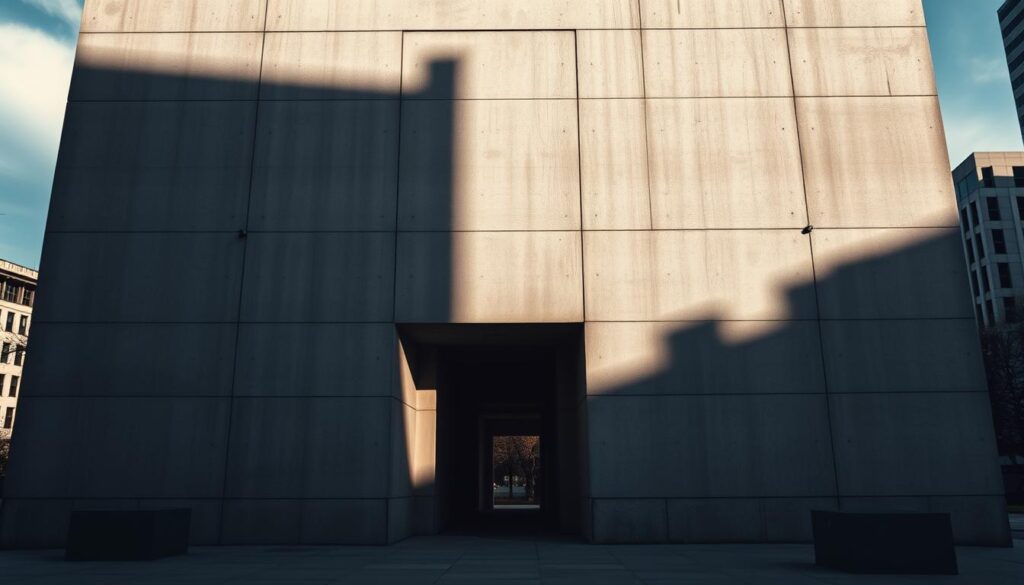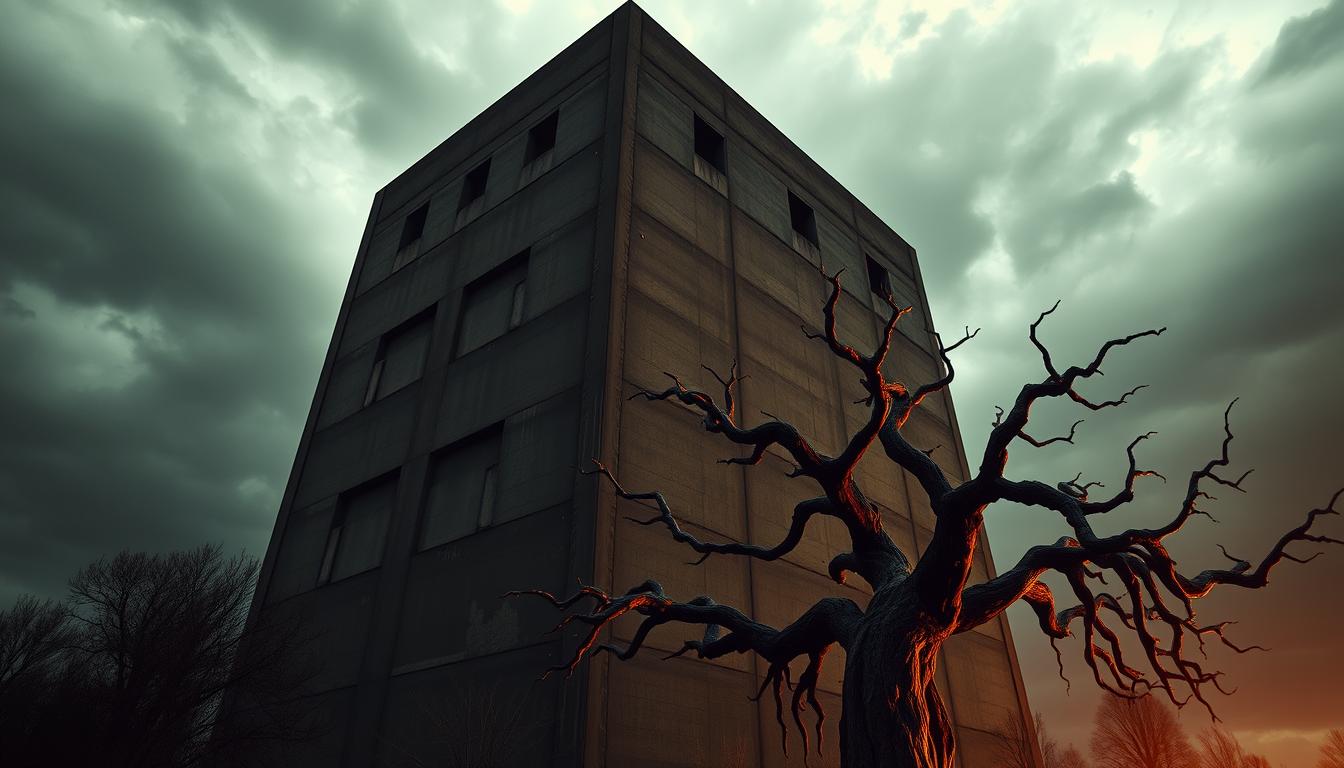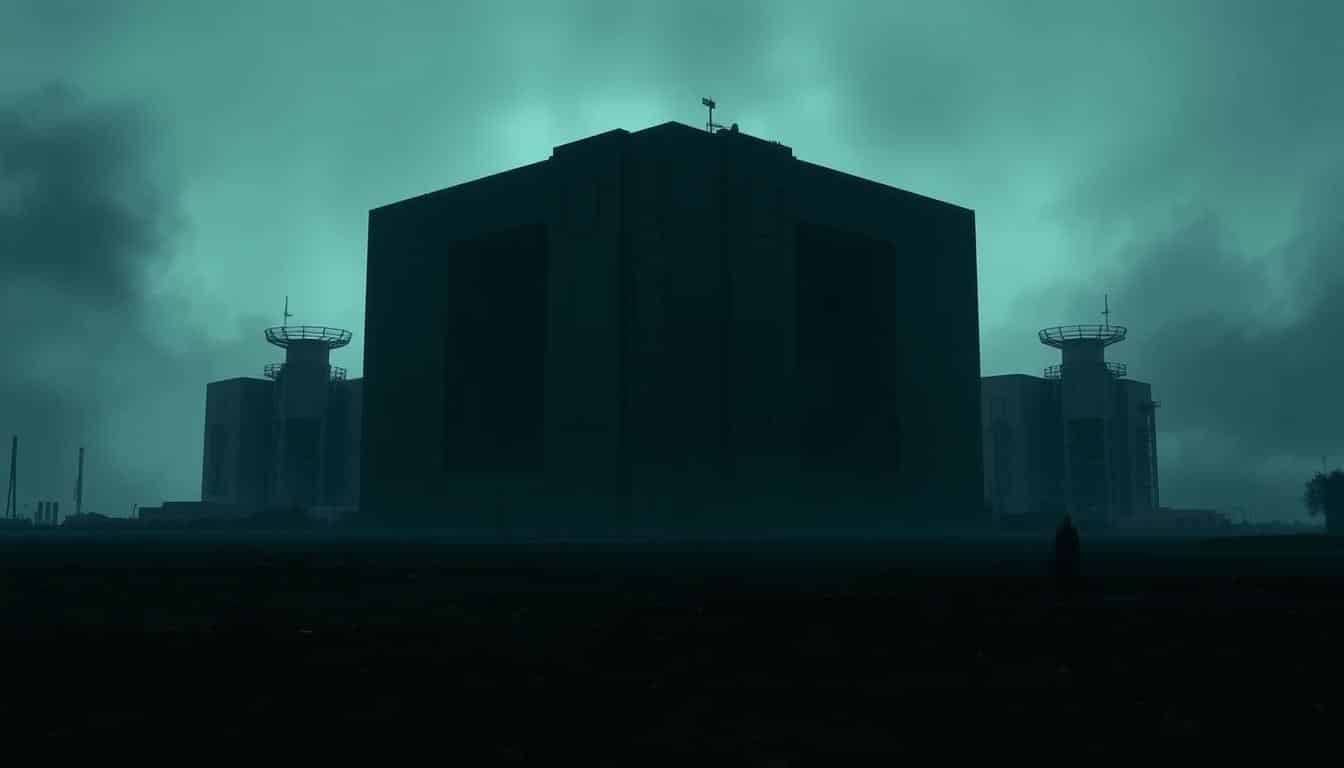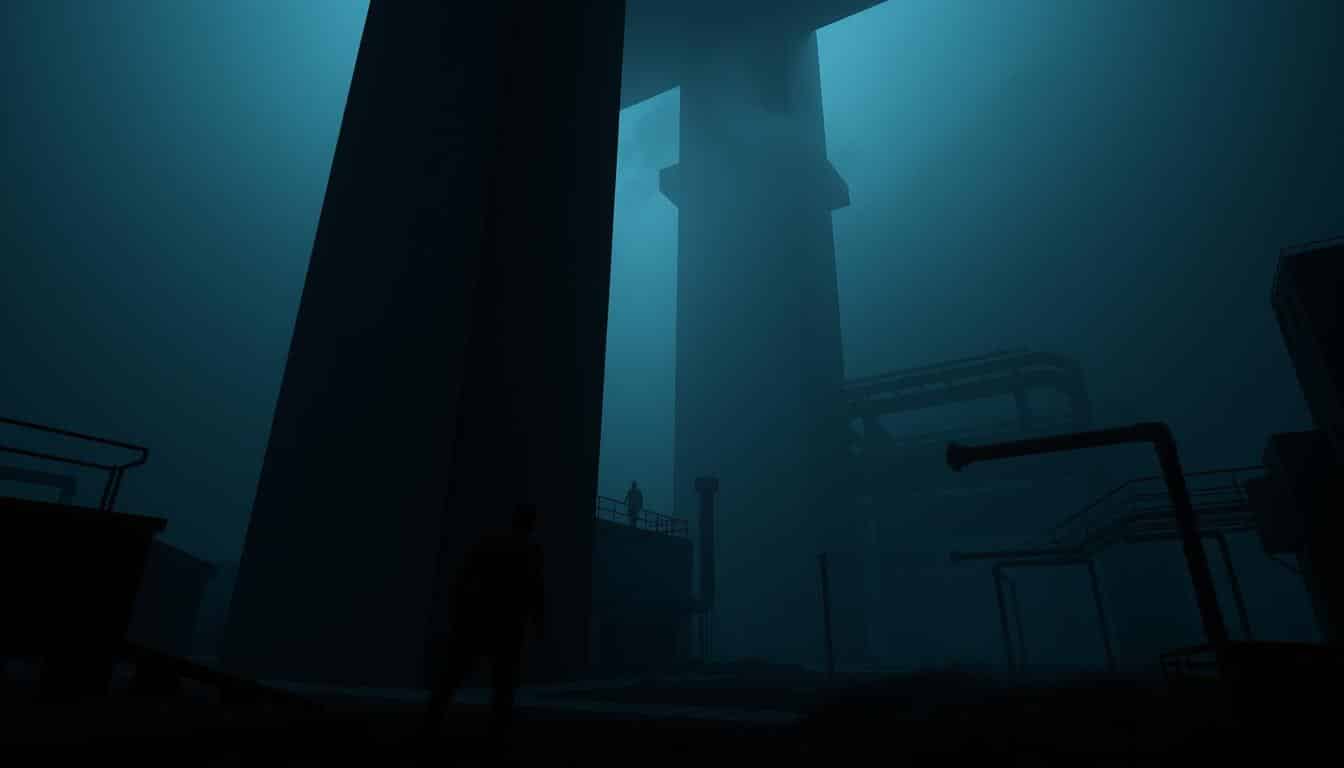Brutalism popped up in the mid-20th century, known for its bold use of concrete and simple looks. This style affects psychological horror and architectural tension. It creates feelings of unease and emotional distance.
The look of Brutalism deeply influences horror in architecture and movies. By looking at Brutalism and psychological horror together, we see how these buildings cause strong mental reactions. This shapes both real and cinematic worlds.
The Brutalist Aesthetic: Origins and Characteristics
Brutalist architecture started in the mid-20th century. It came about because there was a lot to rebuild after World War II. This style focused on raw materials and keeping designs practical. It moved away from the complex designs of the past, valuing simplicity and transparency in building.
The look of Brutalist buildings is defined by exposed concrete and sharp shapes. This approach is all about use over beauty. For example, the National Temple of Mary in Italy and the Heilig-Kreuz-Kirche in Vienna show this. They stand out with their bare look, which might make people feel a bit lonely or lost.

Architects of Brutalist buildings believed their works should tell a tale. They highlight strength and lastingness through their bold forms. This often results in big, single-piece designs that stand tall, making the area feel grand yet somewhat foreign.
How Brutalism fosters tension and psychological horror
Brutalism stands out with its raw concrete and geometric shapes. It creates powerful emotional reactions. The concrete’s impact is huge in making people feel experiences deeply. Brutalism’s bare look can make you feel uneasy and small. Its design does more than just look a certain way. It touches our deepest feelings.
Concrete and its Psychological Effects
Concrete is a big reason why Brutalist buildings affect us deeply. Being in large, empty concrete places can make you feel:
- Isolated and abandoned
- Cold and lifeless
- Disconnected from the world
This happens because concrete feels cold and uninviting. It doesn’t feel cozy or welcoming. When people move through these stark places, they often feel a strong sense of fear.
The Use of Monolithic Structures in Brutalism
In Brutalism, giant structures are important. They create spaces that really stand out. These huge shapes can make you feel:
- Scared because they’re so big
- Defenseless because of their bareness
- Shaken up by the huge empty spaces they form
These features create a world of tension and unease. It shows how architecture and fear can mix. Monolithic structures touch on our greatest worries, making us face the uneasiness of living in such spaces.
Brutalism and the Post-War Context
After World War II, Europe had to rebuild from much destruction. This time led to new architectural ideas, breaking old norms. Brutalism stood out, born from the need to heal a hurt society. It showed strength and the deep marks left by war through its use of concrete.
Architectural Responses to Destruction
Post-war architecture showed toughness from past pain. Architects had the huge job of rebuilding destroyed cities. They moved away from traditional styles. Brutalism focused on being useful and simple, using basic materials. This style was about building again with meaning, mixing the feel of loss with the hope for better times. Key features include:
- Utilization of inexpensive materials to facilitate rapid rebuilding.
- Large-scale, monolithic structures that often convey a sense of stability.
- Open spaces designed to foster community and collective healing.
Collective Trauma and Architectural Expression
Deep shared loss shaped the buildings of the post-war period. The heavy feelings of a society in mourning showed in Brutalist designs. These designs didn’t just provide a safe place. They were like a public canvas, touching on sadness, toughness, and remembering. Key characteristics of this architectural style include:
- The representation of scars and unfinished narratives through raw concrete surfaces.
- Structures that invite reflection and contemplation within their stark environments.
- An embodiment of both personal and societal healing through shared spaces and experiences.
Brutalist Structures in Film and Media
Brutalist architecture in movies provides a strong visual style. It often represents evil, especially in horror movies. The bold and heavy look of Brutalist buildings creates eerie settings. This boosts the psychological tension felt by viewers. Filmmakers use these architectural forms to increase stories of fear, with concrete buildings symbolizing isolation and threat.
Visual Language of Evil in Cinematic Spaces
Brutalist structures are known for making people feel uneasy. Their sharp shapes and rough textures often symbolize inner conflict and the decline of society. In “A Clockwork Orange,” the buildings show the main character’s turmoil and the world’s visual wickedness. This unique style of architecture makes viewers more involved. It does this by supporting the creepy stories being told.
Case Studies: Iconic Brutalist Locations in Horror Films
Many horror movies use Brutalist architecture’s unique aspects to make a strong impact. For example, the Overlook Hotel in “The Shining” shows how design can add to a movie’s scary mood. Its daunting halls and concrete look give a feeling of being trapped. This pulls viewers deeper into the horror.
“The Exorcist” and “The Terminator” also use these buildings to highlight danger and evil. These films show how Brutalist architecture can deeply affect horror movies. It connects viewers directly to the evil seen on screen.
Architects and the Psychological Roots of Brutalism
Studying the lives and works of key architects shows how their tough experiences shape Brutalist architecture. Le Corbusier and Walter Gropius faced hardships that influenced their design ideas. Their works reflect their personal feelings, making their buildings more than just structures.
Le Corbusier: A Journey Through Trauma
Le Corbusier grew up in an unstable environment. This left a mark on his mind. His buildings often feel cold and distant. This style can make people feel alone, showing the scars from his early life trauma. He thought design could change human experiences. But, his buildings sometimes feel unwelcoming.
Walter Gropius and Post-Traumatic Architecture
Walter Gropius went through the horrors of World War I. This deeply affected his view on architecture. His designs are a way to deal with the war’s trauma. Gropius used modernist elements, like raw materials and sharp lines, to show toughness and sadness.
His architecture talks about society’s suffering but also its hope for the future. It shows the link between trauma and creativity in building design.
The Role of Brutalism in Religious Architecture
Brutalist churches mark a clear break from old religious buildings. They make people feel differently than traditional churches do. The raw concrete and simple shapes can make these spaces feel less warm and inviting.
Emotional Impact of Brutalist Churches
The feeling you get from Brutalist churches is deep. Take St. Francis de Sales Parish Church, for example. Its look can make you feel alone, even though it’s meant to bring people together. The tough lines and simple design can make welcoming feelings hard to come by.
Disconnecting Worship from Tradition
Brutalist churches symbolize a big change in religious architecture. They often move away from old styles on purpose. This change can make worshippers feel distant from their faith’s rituals and deeper meanings. It raises questions about how design affects our religious experiences. These spaces show the tough challenges and realities of today’s religious buildings.
The Alienation and Sterility of Brutalist Spaces
Brutalist architecture features plain concrete structures and a simple style. This often makes people feel isolated and cold. The way these buildings affect us is crucial in the study of environmental psychology. It helps us see the bigger picture of life and work in such places.
Psychological Effects of Environment on Behavior
Brutalist buildings often make people feel disconnected. Studies show that being around such harsh environments can lead to stress. Key reasons for this include:
- Limited natural light and air
- A lack of warmth and decoration
- Big, dominating buildings
This can discourage people from being social. It creates a cold vibe where people might feel alone.
Public Perception and Acceptance of Brutalism
Not everyone sees Brutalism the same way. Some love its straightforwardness and the focus on function over looks. But others think it’s harsh and unwelcoming. These mixed feelings affect how people react to Brutalist buildings. Important points include:
- Some celebrate its plain design as art
- Others dislike it because it feels alienating and lacks welcoming spaces
- There’s a continuous discussion on Brutalism’s place in our cities
The conversation about accepting these buildings is still changing. It shows how different people have different views on their impact on our lives.
Brutalism as a Cultural Icon of Horror
Brutalism has become a symbol closely tied to horror. Its portrayal in the media often makes us feel scared and uneasy. This ties Brutalism to a narrative that it is something evil. The way a building’s design can change how we see it reminds us of the power of perception.
Stereotypes and Associations with Evil
Around Brutalism, stereotypes of darkness have grown. Its tough and heavyweight look gives it a harsh vibe. Films use Brutalism to show characters’ bad sides, suggesting these places are up to no good.
- Visual language that emphasizes harsh angles and somber colors.
- Recurring themes in horror narratives where Brutalist structures serve as settings for malevolent actions.
- The representation of characters who inhabit these spaces often aligning with villainous traits.
The Media’s Role in Shaping Brutalism’s Identity
The media has a big hand in linking Brutalism with horror. By showing these buildings in scary settings, it deepens our fear of isolation and sadness. This has made Brutalist buildings a symbol of creepiness in our minds.
- Film settings that emphasize the contrast between the buildings’ cold exteriors and human emotion.
- Documentaries that explore Brutalism while highlighting its unsettling characteristics.
- Social media discussions that continuously link the aesthetic to psychological unease.
Exploring Mental Mapping in Architectural Design
Mental mapping plays a crucial role in how we perceive and navigate our surroundings. In Brutalist architecture, this idea is even more important. These stark, imposing structures can confuse people, affecting their mental state. Architectural design impacts how safe and comfortable we feel. It can also make us feel uneasy or scared.
How Spatial Disorientation Contributes to Psychological Horror
Spatial disorientation causes confusion in poorly designed spaces. Brutalist buildings, with their harsh designs, can make people feel isolated and anxious. It’s hard for some to get a mental picture of these places. This leads to more discomfort. Features like:
- Complex layouts
- Inconsistent sight lines
- Unpredictable pathways
These aspects make the architecture seem oppressive. They can trigger fear or claustrophobia. This is especially true in cities filled with these buildings.
Historical Examples of Architectural Oppression
Architecture has been used to oppress and control throughout history. Examples include:
- The panopticon, designed for surveillance and control.
- Government buildings that promote fear and submission.
- Housing projects that hinder community interaction.
Such oppressive designs show how architecture can spread despair and isolation. By studying these cases, we learn the deep impact of architecture and mental mapping on people and society. The scars left by spatial disorientation in these buildings underscore the need for thoughtful design.
The Future of Brutalism in Urban Landscapes
The future of Brutalism in cities is now a hot topic. Fans of this style see its importance in modern history. But others like buildings that feel warmer and more welcoming. This trend faces the tough task of mixing Brutalism’s bold look with spaces that make our lives better.
Renewed Interest in Brutalism: A Double-Edged Sword
The growing love for Brutalism in cities is tricky. For some, its sturdy, simple style symbolizes strength. Yet, others find these buildings too cold and unwelcoming. This split creates different ideas about their place in our future. Considerations in this include:
- Brutalist buildings’ history and cultural value.
- Efforts by communities to keep architectural uniqueness.
- How new design trends focus on sustainability and connecting people.
Balancing Aesthetics with Human Experience
Cities do best when their designs meet people’s needs. Brutalism’s future makes us think about how big concrete buildings and friendly spaces can blend. To do this well might mean:
- Softening Brutalist styles with designs focused on people.
- Adding green spaces and areas for community to boost well-being.
- Designing flexible spaces that promote getting together.
With these steps, we aim to keep Brutalism but in a way that improves city life for everyone.
Conclusion
Our deep dive into Brutalism shows how it blends with psychological horror and tension. This mix of architecture’s look, history, and our feelings shows its power. Brutalism’s bare concrete and huge shapes can make us uneasy, showing the dark sides of life.
Brutalism is admired for its daring but also known for making people feel apart. This piece looked at how Brutalism brings out fear through its bare look and history with troubled times after wars. Today, it’s key to think about what this style means, noticing how it can amaze us and make us uneasy.
Our talks on Brutalism help us see its role in design and its effect on our feelings. Looking forward, keeping this conversation going is important. It helps us see how Brutalism shapes our world and connects with our emotions in the spaces we live and work.



